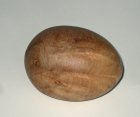By “ovoid” I mean a turned object whose outline is what you would obtain if you took two spheroids of the same maximum diameter but different lengths, cut each in half, and joined half of one to half of the other. By choosing the parameters of the two spheroids carefully, you can obtain a reasonable approximation of many bird eggs. The good news is that you do not really have to turn two spheroids and recombine them; you can easily turn the ovoid directly. How? Simply follow the procedure described in the companion article “Simple Aid for Turning Spheres and Spheroids Without a Jig” with a minor modification.
Start by turning a cylinder of the desired diameter and define the length of the ovoid by parting in a bit. Next, mark with a line the desired position of the maximum width of the ovoid.
Next, for convenience, draw on paper two simple figures. One is a rectangle whose width is equal to the diameter of the cylinder and whose length is twice that of the left-hand segment of the marked up cylinder. The other is a rectangle whose width is equal to the diameter of the cylinder and whose length is twice that of the right-hand segment of the marked up cylinder.
With these preliminaries, the Stage 1 and Stage 2 turning procedures are as described in the cited article except that when laying the markings for the cuts for the two ends, refer to the appropriate rectangle for the values D, L and H. Note that H is the diagonal length of the rectangle.

Start by turning a cylinder of the desired diameter and define the length of the ovoid by parting in a bit. Next, mark with a line the desired position of the maximum width of the ovoid.
Next, for convenience, draw on paper two simple figures. One is a rectangle whose width is equal to the diameter of the cylinder and whose length is twice that of the left-hand segment of the marked up cylinder. The other is a rectangle whose width is equal to the diameter of the cylinder and whose length is twice that of the right-hand segment of the marked up cylinder.
With these preliminaries, the Stage 1 and Stage 2 turning procedures are as described in the cited article except that when laying the markings for the cuts for the two ends, refer to the appropriate rectangle for the values D, L and H. Note that H is the diagonal length of the rectangle.

